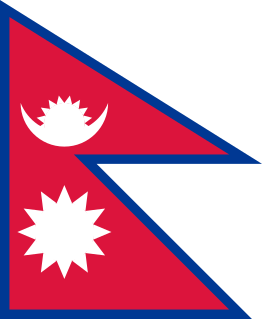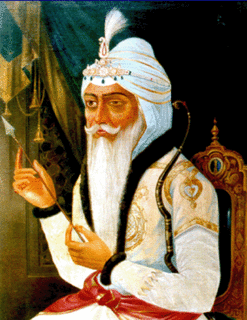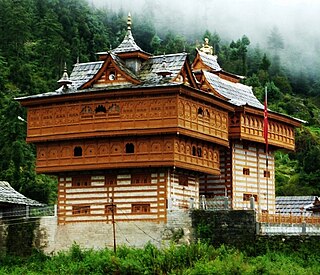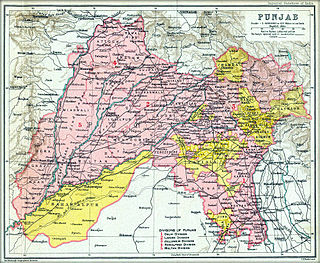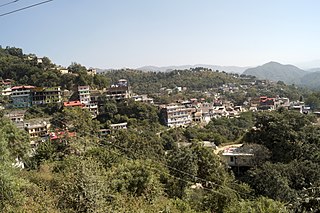| Bushahr State | |||||
| Princely State of British India | |||||
| |||||
 | |||||
| History | |||||
| • | Established | 1412 | |||
| • | Independence of India | 1948 | |||
| Area | |||||
| • | 1941 | 8,907 km2(3,439 sq mi) | |||
| Population | |||||
| • | 1941 | 115,000 | |||
| Density | 12.9 /km2 (33.4 /sq mi) | ||||
Bushahr, also spelt as 'Bashahr' and 'Bussahir' or 'Bushair' was a princely state in India during the British Raj. It was located in the hilly western Himalaya promontory in the northern part of colonial Punjab.

A princely state, also called native state, feudatory state or Indian state, was a vassal state under a local or regional ruler in a subsidiary alliance with the British Raj. Though the history of the princely states of the subcontinent dates from at least the classical period of Indian history, the predominant usage of the term princely state specifically refers to a semi-sovereign principality on the Indian subcontinent during the British Raj that was not directly governed by the British, but rather by a local ruler, subject to a form of indirect rule on some matters. In actual fact, the imprecise doctrine of paramountcy allowed the government of British India to interfere in the internal affairs of princely states individually or collectively and issue edicts that applied to all of India when it deemed it necessary.

India, also known as the Republic of India, is a country in South Asia. It is the seventh largest country by area and with more than 1.3 billion people, it is the second most populous country as well as the most populous democracy in the world. Bounded by the Indian Ocean on the south, the Arabian Sea on the southwest, and the Bay of Bengal on the southeast, it shares land borders with Pakistan to the west; China, Nepal, and Bhutan to the northeast; and Bangladesh and Myanmar to the east. In the Indian Ocean, India is in the vicinity of Sri Lanka and the Maldives, while its Andaman and Nicobar Islands share a maritime border with Thailand and Indonesia.

The British Raj was the rule by the British Crown in the Indian subcontinent from 1858 to 1947. The rule is also called Crown rule in India, or direct rule in India. The region under British control was commonly called British India or simply India in contemporaneous usage, and included areas directly administered by the United Kingdom, which were collectively called British India, and those ruled by indigenous rulers, but under British tutelage or paramountcy, and called the princely states. The whole was also informally called the Indian Empire. As India, it was a founding member of the League of Nations, a participating nation in the Summer Olympics in 1900, 1920, 1928, 1932, and 1936, and a founding member of the United Nations in San Francisco in 1945.
Contents
The territory of this former state is now part of Kinnaur and Shimla district of the Indian republic's state of Himachal Pradesh. The erstwhile Bushahr state was traversed by the Sutlej river. It had an area of 8,907 km².
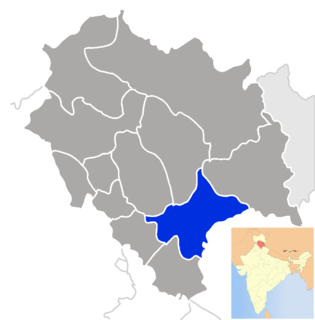
Shimla district of Himachal Pradesh lies between longitude 77.00" and 78.19" east and latitude 30.45" and 31.44" north, with its headquarters in Shimla. It is surrounded by Mandi and Kullu in the north, Kinnaur in the east, Uttarakhand in the southeast, Solan to the southwest and Sirmaur in the south. The elevation of the district ranges from 300 metres (984 ft) to 6,000 metres (19,685 ft).

Himachal Pradesh is a state in the northern part of India. Situated in the Western Himalayas, it is bordered by states of Jammu and Kashmir on the north, Punjab on the west, Haryana on the southwest, Uttarakhand on the southeast, and Tibet on the east. At its southernmost point, it also touches the state of Uttar Pradesh. The state's name was coined by acharya Diwakar Datt Sharma, one of the state's eminent Sanskrit scholars.

The Sutlej River (Punjabi: ਸਤਲੁਜ, Sanskrit: शतद्रुम, , is the longest of the five rivers that flow through the historic crossroads region of Punjab in northern India and Pakistan. The Sutlej River is also known as Satadree It is addressed as Shatarudra by the Gorkhalis. It is the easternmost tributary of the Indus River.

